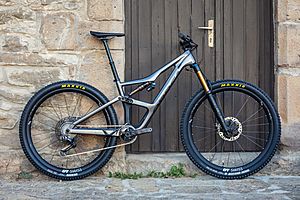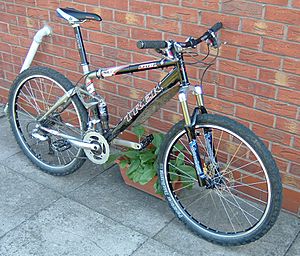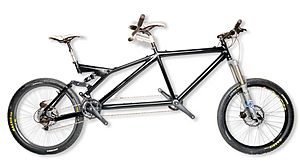Mountain bike facts for kids
A mountain bike (often called an MTB) is a special kind of bicycle. It's built for riding off-road, like on dirt trails, rocky paths, and steep hills. Mountain bikes look a bit like regular bikes, but they have strong parts to handle rough ground. This makes them tougher and heavier than bikes you ride on smooth roads.
Some key features of a mountain bike include special front shocks (called a suspension fork), big, bumpy tires for grip, and super strong wheels. They also have powerful brakes and wide handlebars to help you balance. The gears are designed to help you climb steep hills or go fast downhill. Many mountain bikes also have rear suspension for an even smoother ride. Some even have a "dropper post" that lets you quickly move the seat up or down while riding.
Mountain bikes are perfect for trails, narrow paths (called singletrack), and dirt roads. These places often have rocks, roots, loose dirt, and big slopes. You might also find fun obstacles like log piles, rock gardens, or jumps. Mountain bikes are made to handle all these challenges. Because they are so strong, some people also use them in cities to ride over potholes and curbs.
Contents
Types of Mountain Bikes and Riding Styles
Since mountain biking became popular in the 1970s, many different styles of riding have developed. Each style needs a slightly different bike design.
- Cross-country (XC) riding is about speed and endurance over varied terrain.
- Enduro and All-mountain riding involve climbing hills and then racing down them.
- Freeride and Downhill biking are all about going fast down very steep and challenging trails.
Bikes have changed a lot over time. Suspension (the shock absorbers) can now move up to 8 inches (200 mm) to soak up big bumps. Gears have also improved, with some bikes now having 13 speeds. Many modern mountain bikes use a "1x" (pronounced "one-by") gear system. This means they have just one gear ring at the front and many gears at the back. This makes the bike lighter and simpler to use.
The Story of Mountain Bikes
How Mountain Bikes Began
The first mountain bikes were actually heavy old cruiser bikes that people changed. Riders in Northern California, USA, started using these bikes in the 1970s to ride down mountain trails. They called these modified bikes "ballooners" or "klunkers."
A bike builder named Joe Breeze took this idea and created what many consider the first real mountain bike. Later, in the late 1970s and early 1980s, bigger bike companies started making mountain bikes. They used new, lighter materials like aluminum. The first mountain bike you could buy was the 1979 Lawwill Pro Cruiser.
The first mountain bike made for everyone was the Specialized Stumpjumper, which came out in 1981. Mountain biking quickly became very popular. By the 1990s and 2000s, it grew into a big sport with international races and championships.
Different Kinds of Mountain Bikes
Mountain bikes can be grouped into four main types based on their suspension:
- Rigid: These bikes have big, knobby tires and straight handlebars, but no suspension at all.
- Hardtail: These bikes have suspension forks for the front wheel, but the back part of the frame is solid.
- Soft Tail: A newer type of bike that has a frame that can flex a little to absorb some bumps, but no actual rear shock absorber. These are usually for cross-country riding.
- Full Suspension (or Dual Suspension): These bikes have suspension for both the front and back wheels. The front suspension looks like a motorcycle's fork, and the back has a special system to absorb shocks.
Modern Bike Features
Gears and How They Work
Mountain bikes have had many different numbers of gears over the years, from 7 to 36 speeds! This helps riders tackle all sorts of terrain. Today, many high-end mountain bikes use a "1x" system. This means they have just one gear ring at the front and a wide range of gears (like 11 or 12) at the back. This makes the bike lighter and simpler to shift gears.
How Suspension Helps You Ride
In the past, mountain bikes had no suspension. In the early 1990s, bikes with front suspension forks appeared. This made riding on bumpy trails much easier and less tiring. These first forks had about 1.5 to 2 inches (38 to 50 mm) of travel.
Soon, "hardtail" bikes (with front suspension but a rigid back) became very popular. While hardtails are cheaper and easier to maintain, full suspension bikes are becoming more common. Modern front forks can have 8 inches (200 mm) or more of travel!
Many new mountain bikes have "full suspension," meaning both wheels have shock absorbers. This gives you a super smooth ride because the wheels can move up and down over obstacles. Full suspension bikes are more expensive, but they are much faster and more comfortable on rough trails and downhill sections. This is because the suspension soaks up bumps, so you don't lose speed by bouncing around. The main downsides are more weight and higher cost.
Stopping Power: Disc Brakes
Most new mountain bikes use disc brakes. These brakes offer much better stopping power than older "rim brakes," especially in wet or muddy conditions. Disc brakes are located at the center of the wheel (on the hub), so they stay cleaner and drier.
The main downsides of disc brakes are that they cost more and can be a bit heavier. There are two types:
- Hydraulic disc brakes use oil to push the brake pads. They cost more but work very well.
- Mechanical disc brakes use wires to pull the pads. They are usually cheaper.
Wheels and Tires: Your Bike's Shoes
Mountain bikes have very wide tires. The original size was 26 inches, but now 29-inch and 27.5-inch wheels are very common. Smaller 24-inch wheels are sometimes used for dirt jumping or for younger riders.
The actual size names (like 29-inch) are not exact measurements. A 29-inch wheel, for example, is about 29.15 inches (740 mm) across with a tire on it. 29-inch wheels are often called "29ers," and 27.5-inch wheels are sometimes called "650B bikes."
Tires come in many different patterns for different needs. You can find slick tires for street riding, or very knobby tires for muddy trails. Some tires are made just for the front wheel, and others for the back. You can also get tires designed for specific weather (wet or dry) or terrain (hard or soft dirt). More expensive tires are usually lighter and roll faster. "Sticky rubber" tires give great grip, especially when turning, but they wear out faster.
Tires can use inner tubes, or they can be "tubeless." Tubeless tires are lighter and can be run at lower air pressure, which gives better grip. They also help prevent flat tires caused by pinching the tube.
Two Riders, One Bike: Tandem Mountain Bikes
Yes, you can even find mountain bikes made for two people! These are called tandem mountain bikes. Some don't have suspension, while others have full suspension for both riders to enjoy a smoother ride on the trails.
See also
 In Spanish: Bicicleta de montaña para niños
In Spanish: Bicicleta de montaña para niños
- Bicycle
- Electric bicycle
- Bicycle gearing
- Bicycle suspension
- Downhill mountain biking
- Enduro (mountain biking)
- Freeride mountain-biking movies
- Glossary of cycling
- International Mountain Bicycling Association
- List of bicycle manufacturers
- List of bicycle parts
- Mountain bike racing
- Mountain bike orienteering
- Mountain biking
- Mountain quadracycle
- Mountain unicycling
- National Off-Road Bicycle Association (NORBA)
- Singletrack
- Transrockies
- Cross triathlon
- Mountain Bike Hall of Fame
- UCI Mountain Bike & Trials World Championships







